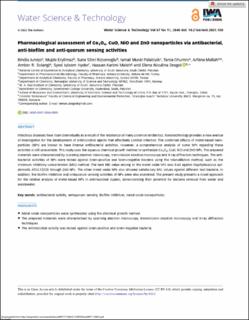| dc.contributor.author | Junejo, Bindia | |
| dc.contributor.author | Eryilmaz, Mujde | |
| dc.contributor.author | Rizvanoglu, Suna Sibel | |
| dc.contributor.author | Palabiyik, Ismail Murat | |
| dc.contributor.author | Ghumro, Tania | |
| dc.contributor.author | Begum Mallah, Arfana | |
| dc.contributor.author | Solangi, Amber R. | |
| dc.contributor.author | Hyder, Syed Iqleem | |
| dc.contributor.author | Maleh, Hassan Karimi | |
| dc.contributor.author | Dragoi, Elena Niculina | |
| dc.date.accessioned | 2023-11-17T08:56:43Z | |
| dc.date.available | 2023-11-17T08:56:43Z | |
| dc.date.created | 2023-08-23T13:28:37Z | |
| dc.date.issued | 2023 | |
| dc.identifier.citation | Water Science and Technology. 2023, 87 (11), 2840-2851. | en_US |
| dc.identifier.issn | 0273-1223 | |
| dc.identifier.uri | https://hdl.handle.net/11250/3103126 | |
| dc.description.abstract | Infectious diseases have risen dramatically as a result of the resistance of many common antibiotics. Nanotechnology provides a new avenue of investigation for the development of antimicrobial agents that effectively combat infection. The combined effects of metal-based nanoparticles (NPs) are known to have intense antibacterial activities. However, a comprehensive analysis of some NPs regarding these activities is still unavailable. This study uses the aqueous chemical growth method to synthesize Co3O4, CuO, NiO and ZnO NPs. The prepared materials were characterized by scanning electron microscopy, transmission electron microscopy and X-ray diffraction techniques. The antibacterial activities of NPs were tested against Gram-positive and Gram-negative bacteria using the microdilution method, such as the minimum inhibitory concentration (MIC) method. The best MIC value among all the metal oxide NPs was 0.63 against Staphylococcus epidermidis ATCC12228 through ZnO NPs. The other metal oxide NPs also showed satisfactory MIC values against different test bacteria. In addition, the biofilm inhibition and antiquorum sensing activities of NPs were also examined. The present study presents a novel approach for the relative analysis of metal-based NPs in antimicrobial studies, demonstrating their potential for bacteria removal from water and wastewater. | en_US |
| dc.language.iso | eng | en_US |
| dc.publisher | IWA Publishing | en_US |
| dc.rights | Navngivelse 4.0 Internasjonal | * |
| dc.rights.uri | http://creativecommons.org/licenses/by/4.0/deed.no | * |
| dc.title | Pharmacological assessment of Co3O4, CuO, NiO and ZnO nanoparticles via antibacterial, anti-biofilm and anti-quorum sensing activities | en_US |
| dc.title.alternative | Pharmacological assessment of Co3O4, CuO, NiO and ZnO nanoparticles via antibacterial, anti-biofilm and anti-quorum sensing activities | en_US |
| dc.type | Peer reviewed | en_US |
| dc.type | Journal article | en_US |
| dc.description.version | publishedVersion | en_US |
| dc.source.pagenumber | 2840-2851 | en_US |
| dc.source.volume | 87 | en_US |
| dc.source.journal | Water Science and Technology | en_US |
| dc.source.issue | 11 | en_US |
| dc.identifier.doi | 10.2166/wst.2023.150 | |
| dc.identifier.cristin | 2169028 | |
| cristin.ispublished | true | |
| cristin.fulltext | original | |
| cristin.qualitycode | 1 | |

